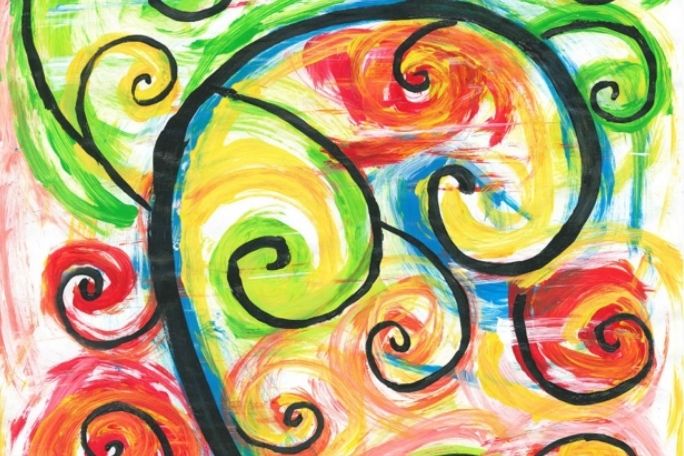Lesson summary
This is a STEAM lesson, which adds the Arts to STEM (Science, Technology, Engineering and Mathematics). To find out more about STEAM and STEM click here.
During this lesson, students will investigate whether mathematics, predominantly the Fibonacci sequence, can be used to model real-life beauty. Students will explore the occurrences of Fibonacci numbers, fractals and the Golden ratio in art and nature, then decide for themselves whether or not trends do occur. They will use the main ideas of each of these mathematical concepts to design an artwork that is calculated to be effective and then judge whether or not the artwork succeeds. The main project for this lesson may also be completed using introductory programming and robots.
Learning intentions:
Students will...
- be able to recognise mathematical patterns in nature and art, including the Fibonacci sequence
- understand how the Fibonacci sequence, Golden ratio and fractals can be used to make effective artworks
- be able to apply mathematical principles to design an effective artwork
- be able to program a robot to perform a series of simple tasks (extension).
Success criteria:
Students can...
- recognise and use patterns including the Fibonacci sequence
- collect, calculate and compare real values to the Golden Ratio
- draw Fibonacci spirals using different units
- combine different mathematical concepts to plan and create an artwork
- evaluate the role mathematics plays in art and nature
- program a robot to perform a series of simple tasks (extension).
Lesson guides and printables
Lesson details
Curriculum mapping
We encourage you to teach STEAM both through and between disciplines (transdisciplinary).
This lesson could be used across various strands of the curriculum, including Science, Maths, and Visual Arts. Consider focusing on a curriculum strand that will complement other areas of learning you and your students are working on.
Syllabus outcomes: VAS4.1, VAS4.3, VAS4.4, VAS4.5, VAS4.6
General capabilities: Literacy, Ethical Understanding, Critical and Creative Thinking, Personal and Social Capability.
Cross-curriculum priority: Sustainability
Relevant parts of Year 7 Maths achievement standards: Students choose between equivalent representations of rational numbers and percentages to assist in calculations.
Relevant parts of Year 8 Maths achievement standards: Students use mathematical modelling to solve practical problems involving ratios, percentages and rates in measurement and financial contexts.
Relevant parts of Year 9 Maths achievement standards: Students use mathematical modelling to solve practical problems involving direct proportion, ratio and scale, evaluating the model and communicating their methods and findings.
Relevant parts of Years 7 & 8 Visual Arts achievement standards: Students analyse how visual conventions, visual arts processes and materials are manipulated in artworks they create and/or experience. Students generate, document and develop ideas for artworks.
Relevant parts of Year 9 Visual Arts achievement standards: Students draw on inspiration from multiple sources to generate and develop ideas for artworks. They document and reflect on their own visual arts practice.
Unit of work: STEAM Made Simple – Secondary
Time required: 140 mins
Level of teacher scaffolding: Medium – there are many short components to this lesson that the teacher will need to guide students through. Teachers may choose to scaffold tasks for lower-level classes or encourage independent application for higher-level classes
Resources required
- Device capable of presenting a website to the class
- Fractals in Art – Examples
- Fractals in Nature – Examples
- Optional: Mona Lisa, Bathers At Asnieres, Girl With A Pearl Earring
- Resources Required (teacher copy)
- Pine Cone Example Images
- Student Worksheet (one copy per student)
Skills
This lesson is designed to build students’ competencies in the following skills:
- Collaboration
- Communication
- Creativity
- Critical thinking
- Digital literacy
Additional info
STEAM Education
Over recent years, the importance of STEM has been heavily promoted and discussed within fields of education. This has been within the context of ensuring that the next generation of students are provided with relevant knowledge and skills for the 21st century. STEM acknowledges the importance of the interrelated nature of science, technology, engineering and mathematics and the prominence of these skills in a world of continuous technological advancement.
What was missing from this original acronym, however, was an acknowledgement of the vital importance of artistic and creative thinking. The ability to think outside the box to develop artistic and creative solutions.
The relevance of art is integral to success in all of the original STEM areas, and so STEAM education is now moving to the forefront. Significant figures in science and technological advancement (notably Leonardo DaVinci, Albert Einstein and Steve Jobs) valued and applied the contribution of artistic skill into their work and art, design and creativity is also pivotal to success in industries such as marketing, advertising and promotion.
This is an original Cool+ lesson.


Welcome back!
Don't have an account yet?
Log in with:
Create your free Cool.org account.
Many of our resources are free, with an option to upgrade to Cool+ for premium content.
Already have an account?
Sign up with:
By signing up you accept Cool.org's Terms and Conditions(Opens in new tab) and Privacy Policy(Opens in new tab).